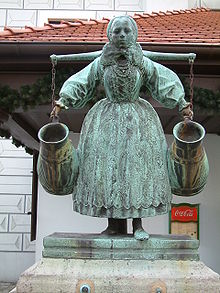Bamberg from Poznan
The Poznań Bambergs (in the Poznań dialect “Poznańskie bambry”, also “Bambrzy”) are the descendants of the settlers from the Franconian Bamberg area who live in the vicinity of Poznan .
In the first half of the 18th century, the rural population around Poznan was decimated due to the Great Northern War and subsequent epidemics. The fields lay fallow. The councilors of Poznań decided to bring settlers from the Bamberg area in Upper Franconia and entrust them with the farming. They were settled in Luboń (1719), in Dębiec, Bonin, Jeżyce and Winiary (1730), in Rataje and Wilda (1746–1747) and again in Jeżyce and Górczyn (1750–1753). Only settlers of Roman Catholic faith were accepted. In total there were about 500 immigrants in 100 families.
The settlers gained more and more recognition among the Poles . Initially there were language difficulties, especially in church. The masses were held in Latin , but there were problems with confession and sermons. Only in the Franciscan Church were there masses in German. In the next generation the children were raised bilingually and there were more and more mixed marriages. The Poles called their German-born neighbors " Bamber " for short (plural " Bambrzy "). The settlers owed their prosperity to their diligence and hard work.
Over time , the Bambergers assimilated more and more, but kept their German family names and German national costumes. During the Kulturkampf , as Catholics, they protested against the forced Germanization of their Polish neighbors.
After 1918 they stayed in reborn Poland and became loyal citizens . Under Nazi rule, they refused to sign the German People's List . Many of them were sent to concentration camps. After 1945 they were viewed with suspicion by the authorities because of their contacts with relatives in the Federal Republic. Only after the fall of 1989 did all prejudices fall. The “Bambry” are valued citizens, the “Bamber” Tomasz Kayser was elected deputy mayor of Poznan.
There is a fountain with the figure of a "Bamberka" on the Old Market Square in Poznan, donated in 1915 by Joseph Wackerle . On festive days the women can be seen in colorful folk costumes. Particularly striking are the cornets, magnificent high headgear worn by young women. Multi-layered skirts are also typical of the "Bamber fashion".
The Poznan Bambergs founded their “Poznan Bamberg Association” (Towarzystwo Bambrów Poznańskich). In 2003 the “Museum of the Poznan Bamber” was established in Poznan. Professor Maria Paradowska took over the management .
Web links
literature
- Maria Paradowska : O historii Bambrów inaczej , (History of the Bambrów Told in a Different Way ), Wydawnictwo Miejskie, Poznań, 2003, ISBN 8389525003



